Antlion
| Antlions Temporal range:Early Cretaceous– Recent
| |
|---|---|

| |
| Distoleon tetragrammicus | |
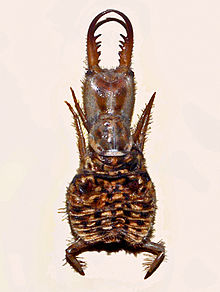
| |
| Distoleon tetragrammicuslarva | |
| Scientific classification | |
| Domain: | Eukaryota |
| Kingdom: | Animalia |
| Phylum: | Arthropoda |
| Class: | Insecta |
| Order: | Neuroptera |
| Superfamily: | Myrmeleontoidea |
| Family: | Myrmeleontidae Latreille,1802 |
| Subfamilies | |
|
seetext | |
Theantlionsare a group of about 2,000speciesofinsectin theneuropteranfamilyMyrmeleontidae.They are known for thepredatoryhabits of theirlarvae,which mostly dig pits to trap passingantsor other prey. In North America, the larvae are sometimes referred to asdoodlebugsbecause of the marks they leave in the sand. The adult insects are less well known due to their relatively short lifespans in comparison with the larvae. Adults, sometimes known asantlion lacewings,mostly fly at dusk or just after dark and may be mistakenly identified asdragonfliesordamselflies.
Antlions have a worldwide distribution. The greatest diversity occurs in the tropics, but a few species are found in cold-temperatelocations, one such being the EuropeanEuroleon nostras.They most commonly occur in dry and sandy habitats where the larvae can easily excavate their pits, but some larvae hide under debris or ambush their prey amongleaf litter.
Antlions are poorly represented in thefossil record.Myrmeleontiformiais generally accepted to be amonophyleticgroup, and within theMyrmeleontoidea,the antlions' closest living relatives are thought to be theowlflies(Ascalaphidae). A 2019 study finds Myrmeleontidae to be monophyletic, aside fromStilbopteryginaeandPalparinae,which form separate clades closer to Ascalaphidae.[1]The predatory actions of the larvae have attracted attention throughout history and antlions have been mentioned in literature since classical times.
Etymology
[edit]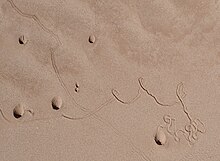
The exact meaning of the name "antlion" is uncertain. It has been thought to refer to ants forming a large percentage of the prey of the insect, the suffix "lion" merely suggesting "destroyer" or "hunter".[2]In any case, the term seems to go back toclassical antiquity.[3]The antlion larva is often called a "doodlebug" inNorth Americabecause of the odd winding, spiralling trails it leaves in the sand while relocating, which look as if someone has beendoodling.[4]
Thescientific nameof thetype genusMyrmeleo– and thus, the family as a whole – is derived fromAncient Greekléon(λέων) "lion" +mýrmex(μύρμηξ) "ant", in aloan translationof the names common across Europe. In most European and Middle Eastern languages, at least the larvae are known under the local term corresponding to "antlion".[3]
Description
[edit]

Antlions can be fairly small to very largeneuropterans,with wingspans ranging from 2 to 15 cm (0.8 to 5.9 in). The African genusPalparescontains some of the largest examples.Acanthaclisis occitanicais the largest European species, with an 11 cm (4.3 in) wingspan, and most North American species approach this size.[4]
The adult has two pairs of long, narrow, multiveined, translucentwingsand a long, slenderabdomen.Although they somewhat resembledragonfliesordamselflies,they belong to a differentinfraclassofwinged insects.Antlion adults are easily distinguished from damselflies by their prominent, apically clubbedantennaewhich are about as long as the head andthoraxcombined.[5]Also, the pattern of wing venation differs, and compared to damselflies, the adults are very feeble fliers and are normally found fluttering about at night in search of a mate. Adult antlions are typicallynocturnal,and rarely seen by day.[2]
Males of most species have a unique structure, a bristle-bearing knob known as a "pilula axillaris", at the base of the rear wing. The abdomen in males is usually longer than in females and often has an extra lobe. The tip of the abdomen of females shows greater variation than that of males, depending perhaps onovipositionsites, and usually bears tufts of bristles for digging and a finger-like extension.[6]
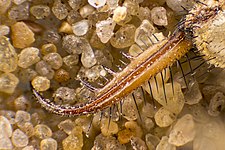
The antlionlarvahas a robustfusiformbody, a very plump abdomen, and a thorax bearing three pairs of walking legs. Theprothoraxforms a slender mobile "neck" for the large, square, flattened head, which bears an enormous pair of sickle-like jaws with several sharp, hollow projections. The jaws are formed by themaxillae and mandibles;the mandibles each contain a deep groove over which the maxilla fits neatly, forming an enclosed canal for injectingvenomto immobilise the victim,[7][8]andenzymesto digest its soft parts. The larva is clad in forward-pointing bristles which help it to anchor itself and exert greater traction, enabling it to subdue prey considerably larger than itself.[9]
Antlion larvae are unusual among insects in lacking ananus.All themetabolicwaste generated during the larval stage is stored; some is used to spin the silk for thecocoonand the rest is eventually voided asmeconiumat the end of itspupalstage.[10]
Distribution
[edit]There are about 2,000 species of antlion found in most parts of the world, with the greatest diversity being in warmer areas. The best known species are those in which the larvae dig pits to trap their prey, but not all species do this. Antlions live in a range of usually dry habitats including open woodland floors,scrub-claddunes,hedge bases, river banks, road verges, under raised buildings and in vacant lots.[11]
Life-cycle
[edit]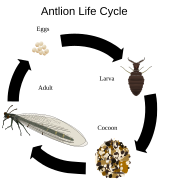
Apart from pit-trap-forming taxa, the biology of members of the family Myrmeleontidae, to which the antlions belong, has been little studied. The life-cycle begins with oviposition (egg-laying) in a suitable location. The female antlion repeatedly taps the prospective laying site with the tip of her abdomen and then inserts her ovipositor into thesubstrateand lays an egg.[12]
Depending on the species and where it lives, the larva either conceals itself under leaves, debris or pieces of wood, hides in a crack or digs a funnel-shaped pit in loose material.[7]Asambush predators,catching prey is risky because food arrives unpredictably and, for those species that make traps, maintaining one is costly. The larvae therefore have low metabolic rates and can survive for long periods without food.[13]They can take several years to complete their life-cycle; they mature faster with plentiful food, but can survive for many months without feeding.[14][15]In cooler climates they dig their way deeper and remain inactive during the winter.[10]

When the larva attains its maximum size, itpupatesand undergoesmetamorphosis.[15]It makes a globular cocoon of sand or other local substrate stuck together with finesilkspun from a slenderspinneretat the rear end of the body. The cocoon may be buried several centimetres deep in sand. After completing its transformation into an adult insect over the course of about one month, it emerges from the case, leaving the pupal integument behind, and works its way to the surface. After about twenty minutes, the adult's wings are fully opened and it flies off in search of a mate. The adult is considerably larger than the larva as antlions exhibit the greatest disparity in size between larva and adult of any type ofholometabolousinsect. This is by virtue of the fact that theexoskeletonof the adult is extremely thin and flimsy, with an exceptionally lowdensity.[16]The adult typically lives for about 25 days, but some insects survive for as long as 45 days.[15]
Ecology
[edit]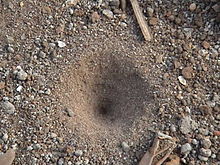
Antlionlarvaeeat small arthropods – mainlyants– while the adults of some species eatpollenandnectar,and others are predators of small arthropods.[17]In certain species of Myrmeleontidae, such asDendroleon pantherinus,the larva, although resembling that ofMyrmeleonstructurally, makes no pitfall trap, but hides indetritusin a hole in a tree and seizes passing prey.[18]In Japan,Gatzara jezoensislarvae lurk on the surface of rocks for several years while awaiting prey; during this time they often become coated withlichen,and have been recorded at densities of up to 344 per square metre.[19]
The larva is a voracious predator. Within a few minutes of seizing its prey with its jaws and injecting it withvenomandenzymes,it begins to suck out the digestion products.[7][9]The larva is extremely sensitive to ground vibrations, the low-frequency sounds made by an insect crawling across the ground; the larva locates the source of the vibrations by the differences in timing of the arrival ofwavesdetected byreceptors,tufts of hairs on the sides of the two hindmost thoracic segments.[20]
Pit-building species
[edit]
Funnel-shaped pits are built by members of just 3 antlion tribes:Myrmeleontini,Myrmecaelurini,andNesoleontini.[21]In these trap-building species, an average-sized larva digs a pit about 2 in (5 cm) deep and 3 in (7.5 cm) wide at the edge. This behavior has also been observed in theVermileonidae(Diptera), whose larvae dig the same sort of pit to feed on ants. Having marked out the chosen site with a circular groove,[22]the antlion larva begins to crawl backwards, using its abdomen as a plough to dig up the soil. Using one of its front legs, it places heaps of loosened particles upon its head which it then flicks clear of the scene of operations. Continuing in this way, it gradually works its way from the circumference towards the center.[2]As it slowly moves round and round, the pit gradually gets deeper and deeper, until the slope angle reaches thecritical angle of repose(that is, the steepest angle the sand can maintain, where it is on the verge of collapse from slight disturbance), and the pit is solely lined by fine grains.[23]By digging in a spiral when constructing its pit, the antlion minimises the time needed to complete the pit.[23]
When the pit is completed, the larva settles down at the bottom, buried in the soil with only the jaws projecting above the surface, often in a wide-opened position on either side of the very tip of the cone.[24]The steep-sloped trap that guides prey into the larva's mouth while avoiding crater avalanches is one of the simplest and most efficient traps in the animal kingdom.[25]The fine grain lining ensures that the avalanches which carry prey are as large as possible.[23] Since the sides of the pit consist of loose sand at its angle of repose,[26]they afford an insecure foothold to any small insects that inadvertently venture over the edge, such as ants. Slipping to the bottom, the prey is immediately seized by the lurking antlion; if it attempts to scramble up the treacherous walls of the pit, it is speedily checked in its efforts and brought down by showers of loose sand which are thrown at it from below by the larva.[2]By throwing up loose sand from the bottom of the pit, the larva also undermines the sides of the pit, causing them to collapse and bring the prey with them. Thus, it does not matter whether the larva actually strikes the prey with the sand showers.[24]
Antlion larvae are capable of capturing and killing a variety ofinsectsand otherarthropods,and can even subdue smallspiders.The projections in the jaws of the larva are hollow and through this, the larva sucks the fluids out of its victim. After the contents are consumed, the dry carcass is flicked out of the pit. The larva readies the pit once again by throwing out collapsed material from the center, steepening the pit walls to the angle of repose.[24]
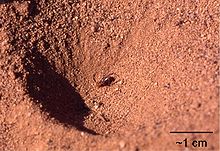
Antlion larvae require loose soil, not necessarily, but often, sand. Antlions can also handle larger granular material which is filtered out of the soil during pit construction.[23]The larvae prefer dry places protected from the rain. When it first hatches, the tiny larva specialises in very small insects, but as it grows larger, it constructs larger pits, and thus catches larger prey, sometimes much larger than itself.[24]
Other arthropods may make use of the antlion larva's ability to trap prey. The larva of the Australian horsefly (Scaptia muscula) lives in antlion (for exampleMyrmeleon pictifrons) pit traps and feeds on the prey caught,[4]and the femalechalcid wasp(Lasiochalcidia igiliensis) purposefully allows itself to be trapped so that it can parasitise the antlion larva by ovipositing between its head and thorax.[27]
Recent research has found that antlion larvae often "play dead" for a variable amount of time (from a few minutes up to an hour) when disturbed to hide from predators. The method is effective; it increased survival rates in patches that use it by 20%.[28]Furthermore, they appear to have maximized its usefulness—further increasing the duration is not likely to convey substantial survival benefits to the larvae.[29]
Evolution
[edit]The closest living relatives of antlions within theMyrmeleontoideaare theowlflies(Ascalaphidae); theNymphidaeare more distantly related. The extinctAraripeneuridaeandBabinskaiidaeare considered likely to be stem groups in the Myrmeleontiformiaclade.[30]Thephylogenyof the Neuroptera has been explored usingmitochondrial DNAsequences, and while issues remain for the group as a whole (the "Hemerobiiformia"beingparaphyletic), the Myrmeleontiformia is generally agreed to bemonophyletic,giving the followingcladogram:[31]
| Neuroptera |
| ||||||||||||||||||||||||||||||||||||
Thesubfamiliesare shown below; a few genera, mostlyfossil,are of uncertain orbasalposition. The fossil record of antlions is very small by neuropteran standards. However, someMesozoicfossils attest to the antlions' origin more than 150 million years ago. These were at one time separated as the Palaeoleontidae, but are now usually recognized as early antlions.[17]
Taxonomy
[edit]The supra-generic classification within the Myrmeleontidae is disputed by different authors. Several different schematics have been proposed.
Stange (2004) classification
[edit]Stange recognized three subfamilies, consisting ofStilbopteryginae,Palparinae,andMyrmeleontinae.[21]Brachynemurinae,Dendroleontinae,and other subfamilies recognized by prior authors[who?]were placed in theMyrmeleontinae.
- StilbopteryginaeNewman, 1853
- StilbopteryginiNewman, 1853
monotypic:StilbopteryxNewman, 1838
- PalparinaeBanks, 1911
- DimariniNavas, 1914
- PalparidiiniMarkl, 1954
- PalpariniBanks, 1911
- PseudimariniMarkl 1954
- MyrmeleontinaeLatreille, 1802
- AcanthaclisiniNavas, 1912
- BrachynemuriniBanks, 1927
- DendroleontiniBanks, 1899
- GnopholeontiniStange, 1994
- LemoleminiStange, 1994
- MauliniMarkl 1954
- MyrmecaeluriniEsben-Petersen, 1918
- MyrmeleontiniLatreille, 1802
- NesoleontiniMarkl, 1954
- NemoleontiniBanks, 1911
Michelet al.(2017) classification
[edit]Michelet.alrecognized just four subfamilies, consisting ofAcanthaclisinae,Myrmeleontinae,Palparinae,andStilbopteryginae..[32]
- StilbopteryginaeNewman, 1853
- StilbopteryginiNewman, 1853
- AcanthaclisinaeNavas, 1912
- AcanthaclisiniNavas, 1912
- PalparinaeBanks, 1911
- DimariniNavas, 1914
- PalparidiiniMarkl, 1954
- PalpariniBanks, 1911
- PseudimariniMarkl 1954
- MyrmeleontinaeLatreille, 1802
- BrachynemuriniBanks, 1927
- DendroleontiniBanks, 1899
- GepiniMarkl, 1954
- GnopholeontiniStange, 1994
- LemoleminiStange, 1994
- MauliniMarkl 1954
- MyrmecaeluriniEsben-Petersen, 1918
- MyrmeleontiniLatreille, 1802
- NesoleontiniMarkl, 1954
Machadoet al.(2018) classification
[edit]A subsequent revision by Machadoet.alrecognized a different four subfamilies:Ascalaphinae,Myrmeleontinae,Dendroleontinae,andNemoleontinae.[21]
- AscalaphinaeRambur, 1842
- AscalaphiniLefèbvre, 1842
- DimariniNavas, 1914
- HaplogleniiniNewman, 1853
- PalpariniBanks, 1911
- StilbopteryginiNewman, 1853
- UlulodiniVan der Weele 1909
- MyrmeleontinaeLatreille, 1802
- AcanthaclisiniNavas, 1912
- BrachynemuriniBanks, 1927
- MyrmecaeluriniEsben-Petersen, 1918
- MyrmeleontiniLatreille, 1802
- NesoleontiniMarkl, 1954
- DendroleontinaeBanks, 1899
- AcanthoplectriniMarkl, 1954
- DendroleontiniBanks, 1899
- GlenuriniBanks, 1927
- MegistopiniNavas, 1912
- NemoleontinaeBanks, 1911
- NemoleontiniBanks, 1911
- ProtoplectriniTillyard, 1916
Jones (2019) classification
[edit]Jones dissented with Machadoet al.and presented an alternative classification, elevating the Ascalaphinae, Palparinae, and Stilbopterygidae of the prior revision to family level and treating only a single subfamily in Myrmeleontidae.[33]However, this classification has been rejected by Hévinet al.(2023), finding the taxonomic decisions to be "not substantiated, with only the family name Palparidae being mentioned in isolation."[34]
- MyrmeleontinaeLatreille, 1802
- AcanthaclisiniNavas, 1912
- BrachynemuriniBanks, 1927
- DendroleontiniBanks, 1899
- MyrmecaeluriniEsben-Petersen, 1918
- MyrmeleontiniLatreille, 1802
- NemoleontiniBanks, 1911
- NesoleontiniMarkl, 1954
-
Antlion larva trails (doodles) in sand
-
Thorax and head (with club-shaped antenna) of antlion adult
-
Larva
-
20x closeup of larva
-
Video of antlion larva trying to catch prey with sand traps and eating a smallspider
-
Video of a larva trapping an ant by throwing sand at it

In culture and folklore
[edit]In popular folklore in the southern United States, people recite a poem or chant to make the antlion come out of its hole.[35]Similar practices have been recorded from Africa, the Caribbean, China and Australia.[36]
TheMyrmecoleonwas a mythical ant–lion hybrid written about in the 2nd century ADPhysiologus,where animal descriptions were paired with Christian morals. The ant-lion as described was said to starve to death because of its dual nature – the lion nature of the father couldonly eat meat,but the ant half from the mother could onlyeat grain chaff,thus the offspring could not eat either and would starve.[37]It was paired with the Biblical verseMatthew 5:37.[38]The fictional ant-lion ofPhysiologusis probably derived from a misreading of Job 4:11.[a][37]
The French naturalistJean-Henri Fabrewrote that "The Ant-lion makes a slanting funnel in the sand. Its victim, the Ant, slides down the slant and is then stoned, from the bottom of the funnel, by the hunter, who turns his neck into a catapult."[39][40]
Antlions appear as antagonists in the 1991life simulationvideo game,SimAnt,and (in a giant form) in theFinal Fantasyseries,Grounded,Terraria,Don't Starve Together,Monster Rancher 2,Mother 3and in theHalf-Life 2video game series as an unrelated alien insect species sharing sand burowing traits with the real antlion larvae. TheTrapinch, Vibrava, and FlygonPokémonevolution line is based on an antlion. The fictionalsarlaccfrom theStar Warsfranchise is often compared to the real-life antlion.[41][42]It also appears as a predator in the filmEnemy Mine.
In the third book ofTove Jansson'sMoominsseries,Finn Family Moomintroll,a rather large and fanciful antlion appears in the second chapter, depicted as a sand-dwelling predator with the literal head of alion.[43]
See also
[edit]- List of Myrmeleontidae genera
- Vermileonidae- wormlions
Notes
[edit]- ^The verse runs "The old lion perisheth for lack of prey, and the stout lion's whelps are scattered abroad." (Authorised Version)
References
[edit]- ^Jones, Joshua R. (November 2019)."Total-evidence phylogeny of the owlflies (Neuroptera, Ascalaphidae) supports a new higher-level classification".Zoologica Scripta.48(6): 761–782.doi:10.1111/zsc.12382.ISSN0300-3256.S2CID208581837.
- ^abcdOne or more of the preceding sentences incorporates text from a publication now in thepublic domain:Pocock, Reginald Innes(1911). "Ant-lion".InChisholm, Hugh(ed.).Encyclopædia Britannica.Vol. 2 (11th ed.). Cambridge University Press. p. 147.
- ^abSwanson, Mark (2007).""Antlion" in the World's Languages ".The Antlion Pit.Retrieved23 February2016.
- ^abcSwanson, Mark (2007)."What are Antlions?".The Antlion Pit.Retrieved23 February2016.
- ^Mares, Michael A. (1999).Encyclopedia of Deserts.University of Oklahoma Press. p. 29.ISBN978-0-8061-3146-7.
- ^Miller, Robert B.; Stange, Lionel A. (1 November 2015)."Glenurus gratus(Say) (Insecta: Neuroptera: Myrmeleontidae) ".Featured Creatures.University of Florida.Retrieved22 February2016.
- ^abcHawkeswood, Trevor J. (2006)."Effects of envenomation to a human finger and arm by the larva of an unidentified species ofMyrmeleon(Neuroptera: Myrmeleontidae) "(PDF).Calodema.7:32–33. Archived fromthe original(PDF)on 2016-03-05.
- ^Nardi, James B. (2009).Life in the Soil: A Guide for Naturalists and Gardeners.University of Chicago Press. p. 170.ISBN978-0-226-56853-9.
- ^abCamp, Donya (2005)."Beneficials in the garden: Antlion".Galveston County Master Gardeners.Extension Horticulture at Texas A&M University.Retrieved28 February2016.
- ^abSwanson, Mark (2007)."Antlion Larvae Behavior: Discarding the Body".The Antlion Pit.Retrieved24 February2016.
- ^Swanson, Mark (2007)."Where do Antlions Live?".The Antlion Pit.Retrieved24 February2016.
- ^McEwen, P.K.; New, T.R.; Whittington, A.E. (2007).Lacewings in the Crop Environment.Cambridge University Press. p. 4.ISBN978-0-521-03729-7.
- ^Jervis, Mark A. (2007).Insects as Natural Enemies: A Practical Perspective.Springer Science & Business Media. p. 28.ISBN978-1-4020-6587-3.
- ^New, T. (1991).Insects as Predators.NSW University Press. p. 69.
- ^abcSwanson, Mark (2012)."Reproductive Behavior".The Antlion Pit.Archived fromthe originalon 4 March 2016.Retrieved23 February2016.
- ^Swanson, Mark (2012)."Metamorphosis".The Antlion Pit.Retrieved23 February2016.
- ^abEngel, Michael S.; Grimaldi, David A. (2007)."The neuropterid fauna of Dominican and Mexican amber (Neuropterida, Megaloptera, Neuroptera)"(PDF).American Museum Novitates(3587): 1–58.doi:10.1206/0003-0082(2007)3587[1:tnfoda]2.0.co;2.S2CID49393365.
- ^Devetak, Dušan; Podlesnik, Jan; Janževocič, Franc (2014)."AntlionDendroleon pantherinus(Fabricius, 1787) (Neuroptera: Myrmeleontidae) in Slovenia ".Acta Entomologica Slovenica.18(2): 159–162.
- ^O'Neal, Matt."Predatory insects"(PDF).MSU.Retrieved23 February2016.
- ^Cocroft, Reginald Bifield (2014).Studying Vibrational Communication.Springer. p. 319.ISBN978-3-662-43607-3.
- ^abcMachado, R. J. P.; Gillung, J. P.; Winterton, S. L.; Garzon-Orduña, I. J.; Lemmon, A. R.; Lemmon, E. M.; Oswald, J. D. (2018)."Owlflies are derived antlions: Anchored phylogenomics supports a new phylogeny and classification of Myrmeleontidae (Neuroptera)".Systematic Entomology.44(2): 418–450.doi:10.1111/syen.12334.
- ^Scharf, Inon; Ovadia, Ofer (2006)."Factors influencing site abandonment and site selection in a sit-and-wait Predator: A review of pit-building antlion Larvae"(PDF).Journal of Insect Behavior.19(2): 197–218.Bibcode:2006JIBeh..19..197S.CiteSeerX10.1.1.565.1350.doi:10.1007/s10905-006-9017-4.S2CID36532488.
- ^abcdFranks, Nigel R.; Worley, Alan; Falkenberg, Max; Sendova-Franks, Ana B.; Christensen, K (2019)."Digging the optimum pit: antlions, spirals and spontaneous stratification".Proceedings of the Royal Society B: Biological Sciences.286(1899): 20190365.doi:10.1098/rspb.2019.0365.PMC6452065.PMID30900535.
- ^abcdCoelho, Joseph R."The natural history and ecology of antlions (Neuroptera: Myrmeleontidae)".Retrieved23 February2016.
- ^Fertin, A. (2006)."Efficiency of antlion trap construction".Journal of Experimental Biology.209(18): 3510–3515.doi:10.1242/jeb.02401.PMID16943491.
- ^Botz, Jason T.; Loudon, Catherine; Barger, J. Bradley; Olafsen, Jeffrey S.; Steeples, Don W. (2003)."Effects of slope and particle size on ant locomotion: Implications for choice of substrate by antlions".Journal of the Kansas Entomological Society.76(3): 426–435.
- ^Piek, Tom (2013).Venoms of the Hymenoptera: Biochemical, Pharmacological and Behavioural Aspects.Elsevier. p. 74.ISBN978-1-4832-6370-0.
- ^Giaimo, Cara (2021-03-07)."The Power of Playing Dead".The New York Times.ISSN0362-4331.Retrieved2021-03-08.
- ^Franks, Nigel R.; Worley, Alan; Sendova-Franks, Ana B. (2021)."Hide-and-seek strategies and post-contact immobility".Biology Letters.17(3): 20200892.doi:10.1098/rsbl.2020.0892.PMC8086978.PMID33653098.
- ^Martill, David M.; Bechly, Günter; Loveridge, Robert F. (2007).The Crato Fossil Beds of Brazil: Window into an Ancient World.Cambridge University Press. p. 334.ISBN978-1-139-46776-6.
- ^Yan, Y.; Wang Y; Liu, X.; Winterton, S.L.; Yang, D. (2014)."The First Mitochondrial Genomes of Antlion (Neuroptera: Myrmeleontidae) and Split-footed Lacewing (Neuroptera: Nymphidae), with Phylogenetic Implications of Myrmeleontiformia".Int J Biol Sci.10(8): 895–908.doi:10.7150/ijbs.9454.PMC4147223.PMID25170303.
- ^Michel, Bruno; Clamens, Anne-Laure; Béthoux, Olivier; Kergoat, Gael J.; Condamine, Fabien L. (February 2017). "A first higher-level time-calibrated phylogeny of antlions (Neuroptera: Myrmeleontidae)".Molecular Phylogenetics and Evolution.107:103–116.Bibcode:2017MolPE.107..103M.doi:10.1016/j.ympev.2016.10.014.PMID27780793.
- ^Jones, Joshua R. (6 October 2019). "Total-evidence phylogeny of the owlflies (Neuroptera, Ascalaphidae) supports a new higher-level classification".Zoologica Scripta.48(6): 761–782.doi:10.1111/zsc.12382.
- ^Hévin, Noémie M.-C; Kergoat, Gael. J.; Clamens, Anne-Laure; Bruno, Le Ru; Mervyn W., Mansell; Michel, Bruno (2023)."Evolution, systematics and historical biogeography of Palparini and Palparidiini antlions (Neuroptera: Myrmeleontidae): Old origin and in situ diversification in Southern Africa".Systematic Entomology.48(4): 600–617.Bibcode:2023SysEn..48..600H.doi:10.1111/syen.12593.hdl:2263/93981.
- ^Howell, Jim (2006).Hey, Bug Doctor!: The Scoop on Insects in Georgia's Homes and Gardens.University of Georgia Press. pp. 15–16.ISBN0820328049.
- ^Ouchley, Kelby (2011).Bayou-Diversity: Nature and People in the Louisiana Bayou Country.LSU Press. p. 85.ISBN978-0807138618.
- ^abDekkers, Midas (2000).Dearest Pet: On Bestiality.Verso. p. 78.ISBN9781859843109.
- ^Grant, Robert M. (1999).Early Christians and Animals.Psychology Press. pp. 61–.ISBN9780415202046.
- ^Fabre, Jean-Henri (2013).Fabre's Book of Insects.Courier Corporation. p. 108.ISBN978-0-486-32011-3.
- ^Fabre, Jean-Henri (2002).The Wonder Book of Science.The Minerva Group. pp. 45–.ISBN978-0-89875-711-8.
- ^Jeanne Cavelos,The Science of Star Wars: An Astrophysicist's Independent Examination of Space Travel, Aliens, Planets, and Robots as Portrayed in theStar WarsFilms and Books(New York: St. Martin's Press, 1999), p. 71,ISBN0-312-20958-4.
- ^Moore, Chris."You Don't Have To Go To A Galaxy Far, Far Away To See These 5 Real Life Star Wars Aliens!".Moviepilot.Archived fromthe originalon 4 February 2017.Retrieved4 February2017.
- ^Jansson, Tove (1950).Finn Family Moomintroll.Penguin Books. p. 33.ISBN978-0-14-030150-2.
External links
[edit]![]() Media related toMyrmeleontidaeat Wikimedia Commons
Media related toMyrmeleontidaeat Wikimedia Commons








